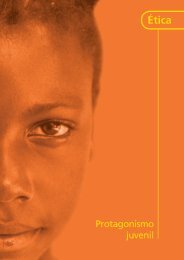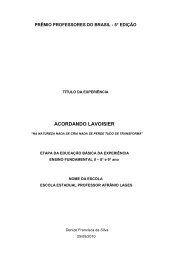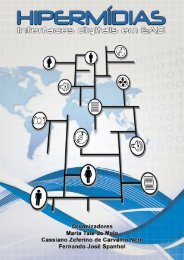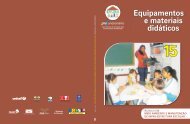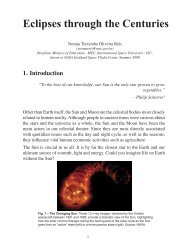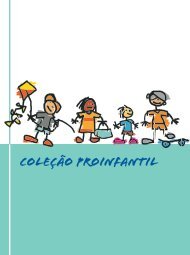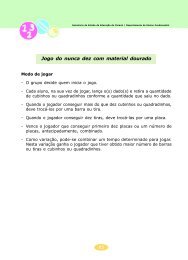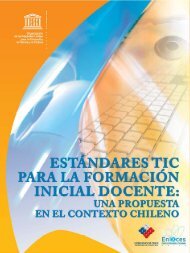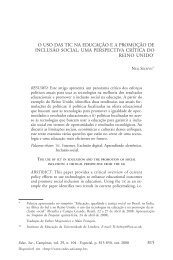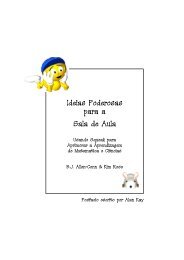BIO-CULTURAL COMMUNITY PROTOCOLS - Portal do Professor
BIO-CULTURAL COMMUNITY PROTOCOLS - Portal do Professor
BIO-CULTURAL COMMUNITY PROTOCOLS - Portal do Professor
You also want an ePaper? Increase the reach of your titles
YUMPU automatically turns print PDFs into web optimized ePapers that Google loves.
PART II / CHAPTER 4<br />
4.1 Bio-cultural and Legal Empowerment<br />
International environmental laws and frameworks are<br />
inaccessible to many forest-dependent communities.<br />
Thus, ILCs require time and information to consider their<br />
options within their local contexts before they can be<br />
expected to make informed decisions within novel legal<br />
and policy frameworks. REDD must support a process that<br />
enables ILCs to reflect upon the inter-linkages and mutually<br />
reinforcing relationships between the forests and their<br />
culture, spirituality and customary laws, and to identify the<br />
bio-cultural foundations of their ways of life in a format<br />
accessible to other REDD stakeholders. ILCs also require<br />
information about REDD and their forest-related rights in<br />
order to better understand the options they have as<br />
communities living in areas that may be affected by<br />
REDD-related policy measures and projects. This will assist<br />
them in clarifying several things for other REDD stakeholders,<br />
including the following: the community’s membership and<br />
traditional authority and territory; their customary laws relating<br />
to sustainable forest use and management; their rights under<br />
international and national law; circumstances under which<br />
they would be required to provide FPIC; and values that would<br />
inform any decisions taken as part of their FPIC. These issues<br />
are discussed in more detail below.<br />
4.2 Mapping Traditional Territories<br />
An important element of a REDD community protocol<br />
would likely be a mapping exercise through which the<br />
community members would identify their traditional<br />
territories and the forest resources they depend on using<br />
modern technologies such as geographic information<br />
systems (GIS) and global positioning systems (GPS). The use<br />
of mapping to help communities articulate their bio-cultural<br />
landscapes can be an empowering process. 18<br />
The<br />
<strong>do</strong>cumentation of traditional land uses can help formalize this<br />
information in a format accessible to Western science<br />
and enable ILCs to disseminate it to other REDD stakeholders.<br />
Mapping exercises introduce communities to the use of<br />
modern technologies that could subsequently enable their<br />
participation in the monitoring, reporting and verification<br />
activities that underpin REDD.<br />
<strong>BIO</strong>-<strong>CULTURAL</strong> <strong>COMMUNITY</strong> <strong>PROTOCOLS</strong> AND REDD<br />
While this will not necessarily solve the problems related to<br />
resource tenure identified above, it may serve as a basis for<br />
a deeper level of ILC participation, inter-stakeholder<br />
communication and engagement.<br />
4.3 Understanding What Conserves Forests<br />
The relationship between ILCs and the forests they live in is<br />
dynamic, and in many cases, their local TK offers great<br />
insight into how to ensure the forest’s conservation.<br />
By articulating aspects of their culture such as bio-spirituality<br />
and customary laws and practices that have helped conserve<br />
the forests, ILCs are able to directly refer to and call upon<br />
the international and national laws intended to support<br />
their traditional ways of life. A REDD community protocol<br />
can be used to express this relationship and examine the<br />
forests within a greater ecological and bio-cultural context,<br />
thus preventing the disembodiment of carbon.<br />
4.4 Free, Prior and Informed Consent<br />
Only legally empowered ILCs can make informed decisions<br />
about how to respond to important decisions relating to the<br />
granting of rights over the forests in which they live.<br />
The empowerment process should include information<br />
about international laws pertaining to forests, indigenous<br />
peoples and other frameworks that support ILCs such as the<br />
Convention on Biological Diversity. Rather than merely<br />
focusing on REDD, communities should gain the capacity<br />
to comprehend how various aspects of their lives are<br />
regulated by a number of laws and to draw on those<br />
most relevant to supporting their en<strong>do</strong>genous plans<br />
for development.<br />
Responding directly to REDD, communities can set out for<br />
other stakeholders their views on the mechanism and assert<br />
their rights to culturally appropriate consultations towards<br />
their free, prior and informed consent (FPIC) to any REDDrelated<br />
policy measures or projects. They can also go beyond<br />
merely stating that they <strong>do</strong> or <strong>do</strong> not want their traditional<br />
territory to be part of a REDD project by defining specific<br />
project elements to be included. ILCs can also identify the<br />
values by which they will assess any projects in order to further<br />
clarify their rights and priorities to other stakeholders.<br />
18. See, for example, the Squamish Nation Land Use Plan in British Columbia, Canada, in which indigenous community members used a map to articulate their vision for<br />
their traditional territories. Available at: http://www.squamish.net/aboutus/xaytemixw.htm. Accessed 10 September 2009.<br />
48




